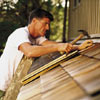Repair Your Own Roof
After the rainy season is over, homeowners tend to turn their attention to spring and summer related home repairs and maintenance, such as landscaping and painting. However, if it's doubtful how much longer you can dare to ignore repairing or replacing you roof, check with a reputable roofing contractor now during the fair weather. You'll find their services more available and economical than in late summer and the fall when their waiting lists and prices inevitably grow.
 Q: I have a yellow stain on the ceiling of my dining room that leads me to believe I may have a roof leak, although I have never noticed water anywhere else. How do I figure out where it is coming from?
Q: I have a yellow stain on the ceiling of my dining room that leads me to believe I may have a roof leak, although I have never noticed water anywhere else. How do I figure out where it is coming from?
A: If you have a stain on the ceiling that appears to be drying out, you can probably rule out the possibility of a plumbing problem and start looking at the roof.
Sometimes a water leak can take up to a year to discover because the drip has to go through the insulation, and then a half inch of drywall before you notice a stain on the ceiling. I've seen roofs that have been leaking for a couple years before the owners noticed. If you ignore it and the water touches any wood, it can become dry rot after a year, which will lead to far more extensive, and expensive damage.
Q: How do you find the source of a roof leak when it is not raining?
A: With over 20 years of experience, I can often climb on a roof and see exactly where it is coming from: a vent, a cracked or curled shingle or broken or cracked tile. These things could have happened from a tree limb falling on a roof, a kid throwing a rock or a major wind storm.
If there is not obvious physical evidence on the top of the roof, then I need to get into the attic. The easiest way is to go into an attic in the middle of the day, close the crawl hole to make sure it is dark, and try to see any sources of daylight coming from the roof. If that doesn't work, we get as much light as possible in the attic and try to find a trail from some point on the roof to the stain. Sometimes a leak can be found as far as 20 feet away from the evidence in the house. Perhaps water travels along the tar paper under the shingles before finding a small hole to enter. Sometimes water will flow along a rafter before dropping onto the ceiling.
When there is no evidence in the attic, we need to spray water from a hose on the roof to recreate the water trail. Sometimes, however, there is no getting around the fact that you need a new roof.
Q: I've been told that I need a new roof, but it is only 15 years old and it was supposed to be a constructed to last 20 years.
A: Severe weather, going from severe heat in the summer to cold, wet, windy winters, causes a lot of expansion and contraction that wears out both wood and composition shingles. Constant shade promotes mildew and moss. Acidic oak leaves can work their way under shingles and sometimes the water that runs across them can eventually burn holes in the tar paper, unseen from the top. I've even seen squirrels and birds bury acorns on roofs that break shingles, etc.
Also, many older roofs were not properly ventilated during construction, causing heat from the attic to deteriorate shingles from the inside as well as the outside. This is why installing new roofing material over an existing roof will not last as long as the original or completely redone roof.
Q: Why won't most roofing contractors come work on my manufactured home?
A: Even if you want to use the same kind of roofing material used on conventional homes, there are other factors involved in working on manufactured homes.
First, the minimal pitch of most manufactured homes causes water to run off more slowly than from steeper pitched roofs on conventional houses, allowing wind to blow water back underneath the shingles. Thus, both the tar paper and the roofing materials must be applied differently to prevent leaks. Even the vents and trim metal differ from those used on conventional homes.
Also, because manufactured homes have a different structure, special concern for the weight of the roofing material, and caution while walking on the roofs of manufactured homes, must be considered. Many manufactured homes have flat roofs which require special preparations, coatings and application techniques, learned only after years of experience.
Finally, I recommend that manufactured homes roofs be inspected often because they move so much more than conventional homes. Flat roofs on manufactured homes are constructed of metal which contracts and expands more than other roofing materials, water tends to pond on the surface and they have seams spaced three to four feet apart. All these factors increase the likelihood of leaks.
by Kathy Maynard, reprinted courtesy of HomeAdvisor.com